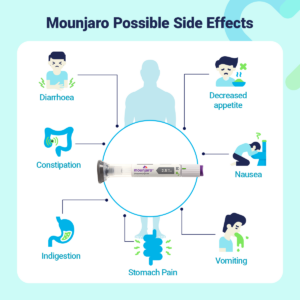When you investigate weight loss medications the phrase GLP-1 receptor agonist will have probably jumped out at you.
This type of medication has had a massive boost in popularity in recent years, and more people than ever are looking into them as weight management treatment.
Naturally, you would want to know a little more about any medication before you consider approaching a prescriber for treatment, and that’s where we can help.
We’re going to explain what GLP-1 receptor agonists are, what their mechanism of action is, and how they can help both obesity and type 2 diabetes treatments.
Let’s start by getting to know what a mechanism of action actually is.
What is a mechanism of action in medicine?
A mechanism of action or MOA is how a medication works in your body – it’s that simple!
When you look into a medicine’s mechanism of action it explains what it will do in your body to treat your illness or condition.
For example, we all know that antihistamines help to prevent your hay fever symptoms, but their mechanism of action is more detailed.
Antihistamines block a hormone called histamine, which is created in your body in response to something you’re allergic to — so blocking histamine is the mechanism of action, stopping allergy symptoms is the result.
Now we’re all clear on that point, let’s look at GLP-1 receptor agonists in more detail.
What are GLP-1 receptor agonists?
GLP-1 receptor agonists are a type of medication used to treat type 2 diabetes and obesity in patients with a BMI of 30 or above.
The acronym stands for glucagon-like peptide-1 receptor agonists, which is quite a mouthful, so most sources typically refer to them as GLP-1 receptor agonists or something similar.
There are quite a few GLP-1 receptor agonists on the market at the moment, some are injectable medications and others come in tablet form but they all work in the same way.
They were first created and licensed to be used as type 2 diabetes medication, helping patients manage their blood sugar levels.
Over time, experts discovered that this treatment was also helping patients to lose weight, which was good news considering the relationship between obesity and type 2 diabetes.
After further testing, certain GLP-1 agonists were also licensed for weight management and the rest is history.
Which medications are GLP-1s?
There are quite a few medications on the market that are classed as GLP1 receptor agonists.
The three we’re most concerned with here at myBMI are Liraglutide, Semaglutide, and Tirzepatide.
Liraglutide is the active ingredient in Saxenda and Semaglutide is the active ingredient in Wegovy, both of these medications are licensed in the UK as weight management treatments.
Tirzepatide has just been licensed in the US as a type 2 diabetes treatment known as Mounjaro, and it will probably be licensed for use as a weight loss medication in future.
Other examples of GLP-1s are only licensed as diabetes treatments, including Exenatide, Dulaglutide, and Lixisenatide.
What is the mechanism of action of GLP-1 receptor agonists?
GLP-1 receptor agonists work by interacting with the hormones created in your pancreas – insulin and glucagon.
It does this by interacting with a type of protein in your pancreas called a GLP-1 receptor — hence the name GLP-1 receptor agonist.
In doing this, it helps to promote the secretion of insulin in your pancreas while slowing glucagon production.
These hormones both play a big part in your hunger levels and blood sugar regulation, so interacting with them is what makes GLP-1 agonists as effective as they are as treatments for obesity and weight loss.
Naturally, there’s more we can say about how these medications work for both conditions specifically, so let’s take a look at the effect this has on weight loss patients first.
What does GLP-1 do for weight loss?
As we’ve just mentioned, GLP-1s increase your insulin secretion and glow down glucagon production.
As these hormones both play a key part in your hunger levels, GLP-1s have been proven to be very effective weight management treatments.
Insulin is produced in your body when your blood sugar level is higher after eating as a sign to your body that it’s time to use up that glucose for energy.
By increasing your insulin production, GLP-1 receptor agonists essentially tell your body that you’ve eaten, helping you feel more satisfied after eating and reducing your appetite.
GLP-1 RAs also slow down gastric emptying, meaning that food leaves your stomach more slowly and you’ll feel fuller for longer.
How do GLP-1 agonists treat type 2 diabetes?
When you have type 2 diabetes it means that your body isn’t creating enough insulin or that the insulin it is making isn’t as effective as it should be.
As insulin controls your blood sugar, this means that type 2 diabetes patients are at risk of complications caused by dangerously high blood sugar.
By increasing your insulin production, GLP-1 receptor agonists help patients to control their blood sugar more effectively, reducing the risk of complications.
As obesity is a significant risk factor for type 2 diabetes, GLP-1s can also help to prevent diabetes in patients with a high BMI.
What is the difference between long-acting and short-acting GLP-1?
The difference between long-acting and short-acting GLP-1 receptor agonists is how often you will need to take the medication.
For example, Semaglutide injections are longer acting than Liraglutide, so you’ll need to take them less often.
This is why Wegovy (Semaglutide) is only injected once a week, whereas Saxenda (Liraglutide) injections are taken daily.
Naturally, this means that some patients will prefer to take one treatment over the other, so if you think a longer or shorter-acting GLP-1 would be a better fit for you you should discuss it in more detail with your prescriber.
Now you know how GLP-1 receptor agonists work, you may be considering trying one for yourself.
If you’d like to learn more about weight management treatments like Semaglutide and Liraglutide you’ve come to the right place.
Check out our treatments page for more information about the services we offer or take a look at one of our other articles for more information about these fascinating medications.


















